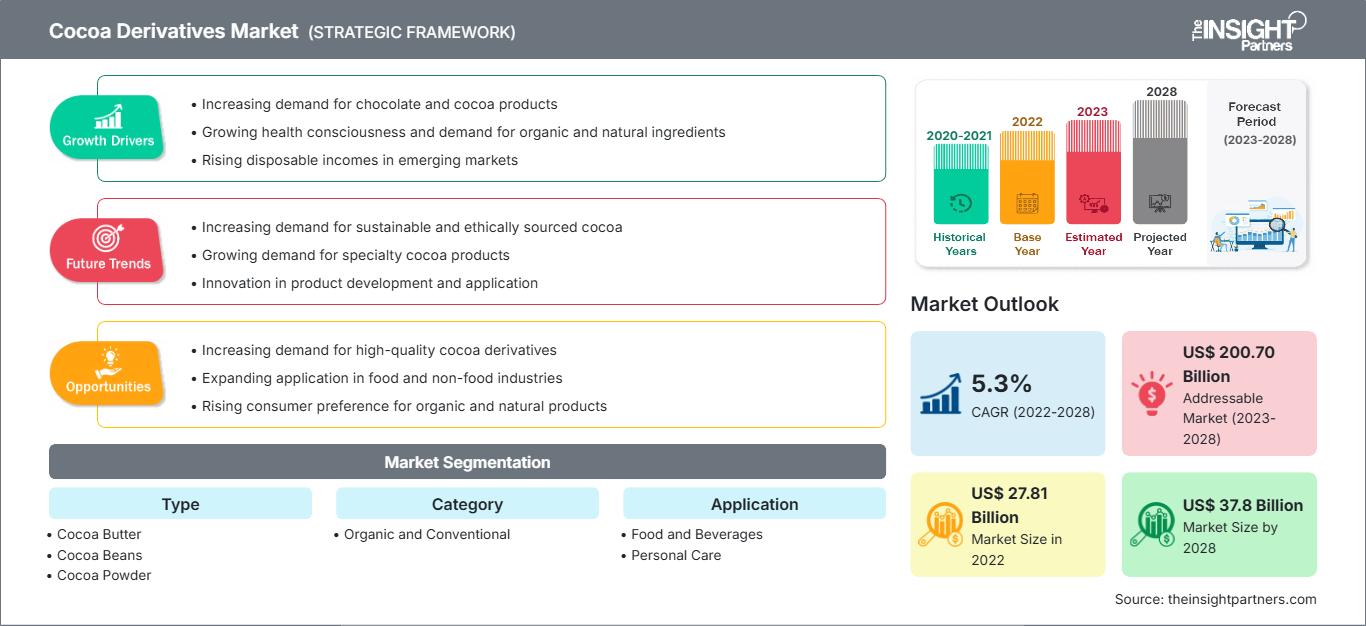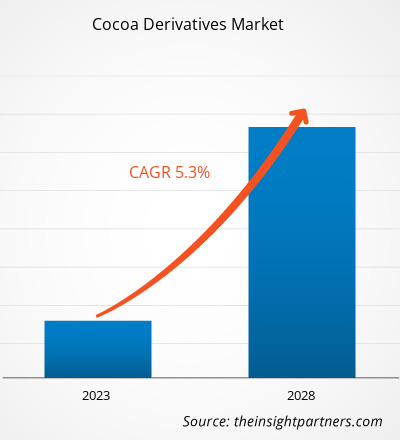可可衍生物市场规模预计将从2022年的278.0713亿美元增长到2028年的377.9986亿美元;预计2022年至2028年的复合年增长率为5.3%。
可可衍生物是通过加工可可而获得的可可产品。可可衍生物的种类包括可可豆、可可脂和可可粉。这些衍生物也分为有机和常规两种。全球市场对有机和公平贸易认证可可豆的需求正在增长。消费者倾向于消费更安全的产品,以帮助他们保持整体健康。人们对无农药食品的兴趣日益浓厚,这对有机种植可可的需求产生了积极影响。根据有机农业研究所 (FiBL) 和国际有机农业运动联合会 (IFOAM) 联合发布的《2022 年世界有机农业报告》,2020 年全球有机可可种植面积达到 3.1%。此外,瑞士莲 (Lindt & Sprüngli) 表示,其在欧洲的有机可可产品销量增长速度远超可可产品整体销量。因此,制造商正在将有机产品添加到其产品组合中,以满足日益增长的需求。例如,百乐嘉利宝 (Barry Callebaut) 提供国产、有机认证、非碱化可可粉。
2022 年,欧洲占据可可衍生物市场的最大份额。预计亚太地区市场在预测期内的复合年增长率最高。该地区市场的增长归因于欧洲人对美味巧克力的日益喜爱。因此,不同的高端巧克力品牌一直在广泛寻找差异化产品的方法,并专注于采购单一产地产品。因此,该地区对高品质可可和单一产地可可口味的需求正在上升。例如,总部位于法国的全球顶级巧克力生产商Valrhona Inc.一直在从位于墨西哥的单一产地可可庄园Maria Trinidad Sanchez采摘可可豆。此外,消费者对健康生活方式的追求也引发了对优质可可衍生物(例如可可脂、可可粉和可可豆)的需求。
自定义此报告以满足您的要求
您将免费获得任何报告的定制,包括本报告的部分内容,或国家级分析、Excel 数据包,以及为初创企业和大学提供超值优惠和折扣
可可衍生品市场: 战略洞察

-
获取本报告的主要市场趋势。这个免费样本将包括数据分析,从市场趋势到估计和预测。
新冠疫情对可可衍生品市场的影响
新冠疫情影响了各国的经济和各行各业。北美、欧洲、亚太地区 (APAC)、南美和中美 (SAM) 以及中东和非洲 (MEA) 的封锁、旅行限制和企业倒闭阻碍了多个行业的增长,包括食品和饮料行业。制造部门的关闭导致全球供应链、制造活动、交付时间表以及必需和非必需产品销售中断。2020 年,许多公司都经历了产品交付延迟和产品销售下滑。此外,欧洲、亚太地区和北美各国政府对国际旅行实施的禁令迫使公司暂时中止合作和伙伴关系计划。所有这些因素在 2020 年和 2021 年初阻碍了各个行业的发展,从而抑制了各个市场的增长。
社会经济形势的变化对 2020 年高端产品的消费模式产生了负面影响。全球危机期间,世界多个国家的政府实施的限制措施导致可可生产规模虽小但重要的可可生产国的农民因疫情初期产量超过需求而遭受经济损失。这导致可可价格大幅下跌。根据国际可可组织 (ICCO) 的数据,2021 年 1 月可可合同价格平均约为每吨 2,528 美元,比上年价格(每吨 2,675 美元)下降了 6%。此外,个人护理、食品和饮料行业影响了可可衍生物市场的表现。
2021年,随着各国政府宣布放宽此前实施的限制措施,多个经济体恢复运营,提振了全球市场。此外,制造商获准满负荷运转,这有助于他们克服供需缺口及其他影响。随着全球大多数人口在2021年之前已完全接种疫苗,可可衍生物制造商专注于扩大生产规模以重振业务。
市场洞察
主要参与者的战略发展有利于可可衍生物市场的增长
2020年9月,奥兰集团有限公司(Olam Group Ltd)面向专业人士推出了奥兰可可(Olam Cocoa),将其优质的德赞(deZaan)可可粉供应给餐厅、餐饮服务商和糕点店。该战略旨在满足专业厨师和烘焙师对高品质可可原料日益增长的需求。市场主要参与者的此类战略发展预计将在未来几年推动可可衍生物市场的增长。
类型洞察
根据类型,可可衍生物市场细分为可可豆、可可脂、可可粉等。可可豆部分在 2022 年占据最大市场份额,而可可粉部分预计在预测期内将实现最高复合年增长率。可可粉是通过压碎从可可树果实中提取的可可豆获得的无糖粉末。将巧克力浆压榨以去除可可脂,然后加工残留的可可固形物以制成优质无糖可可粉。消费者对更佳风味、色泽和质地的追求日益增长,推动了对可可粉的需求。
应用洞察
根据应用,可可衍生物市场细分为食品和饮料、个人护理和其他领域。可可衍生物广泛用于制作烘焙产品、饮料、糖果、乳制品和零食。然而,对清洁标签和纯素产品的新兴需求,导致可可脂、可可粉、可可碎粒和可可液块等植物性成分的销量蓬勃发展。因此,食品和饮料行业对植物性产品的需求不断增长,推动了可可衍生物市场的增长。奥兰国际和嘉吉公司是食品和饮料行业可可衍生物的主要制造商。饮料应用。
Olam Group Ltd、Indcre SA、Cargill Inc、Natra SA、JB Foods Ltd、Ecuakao Group Ltd、United Cocoa Processor Inc、Barry Callebaut AG、Moner Cocoa SA 和 Altınmarka Gıda San ve Tic AS 是可可衍生品市场的主要参与者。这些公司主要专注于产品创新,以扩大市场规模并紧跟新兴趋势。
可可衍生品市场
The Insight Partners 的分析师已详尽阐述了预测期内影响可可衍生品市场的区域趋势和因素。本节还讨论了北美、欧洲、亚太地区、中东和非洲以及南美和中美洲的可可衍生品市场细分和地域分布。
可可衍生品市场报告范围
| 报告属性 | 细节 |
|---|---|
| 市场规模 2022 | US$ 27.81 Billion |
| 市场规模 2028 | US$ 37.8 Billion |
| 全球复合年增长率 (2022 - 2028) | 5.3% |
| 历史数据 | 2020-2021 |
| 预测期 | 2023-2028 |
| 涵盖的领域 |
By 类型
|
| 覆盖地区和国家 |
北美
|
| 市场领导者和主要公司简介 |
|
可可衍生品市场参与者密度:了解其对商业动态的影响
可可衍生品市场正在快速增长,这得益于终端用户需求的不断增长,而这些需求的驱动因素包括消费者偏好的演变、技术进步以及对产品益处的认知度不断提高。随着需求的增长,企业正在扩展产品线,不断创新以满足消费者需求,并抓住新兴趋势,从而进一步推动市场增长。

- 获取 可可衍生品市场 主要参与者概述
报告重点
- 可可衍生品市场不断发展的行业趋势,帮助企业制定有效的长期战略
- 发达国家和发展中国家市场参与者采用的业务增长战略
- 2022 年至 2028 年的市场定量分析
- 全球可可衍生品需求估算
- 波特五力分析,阐明买家和供应商在可可衍生品市场中的效力
- 了解市场竞争格局的最新发展
- 可可衍生品市场的市场趋势和前景,以及增长动力和制约因素
- 通过强调支撑商业利益的市场策略来协助决策过程
- 可可衍生品市场在不同节点的规模
- 可可衍生品市场的详细概述和细分以及增长动态行业
- 各地区可可衍生品市场规模及良好的增长机会
- 历史分析(2 年)、基准年、预测(7 年)及复合年增长率
- PEST和SWOT分析
- 市场规模、价值/数量 - 全球、区域、国家
- 行业和竞争格局
- Excel 数据集
近期报告
客户评价
购买理由
- 明智的决策
- 了解市场动态
- 竞争分析
- 客户洞察
- 市场预测
- 风险规避
- 战略规划
- 投资论证
- 识别新兴市场
- 优化营销策略
- 提升运营效率
- 顺应监管趋势






















 获取免费样品 - 可可衍生品市场
获取免费样品 - 可可衍生品市场